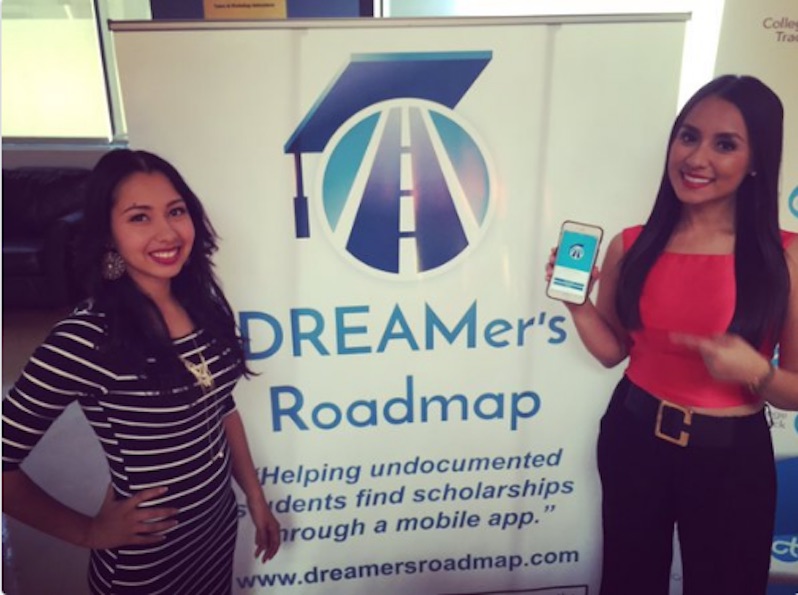Immigration Is Fueling Innovation in Silicon Valley
Former "Dreamer" Sarahi Espinoza Salamanca, now a startup CEO, is among a growing number of Latino entrepreneurs redefining the American tech industry. Sarahi Espinoza Salamanca, left, is the founder and CEO of DREAMer's Roadmap, an app for undocumented students. (Sarahi Espinoza Salamanca / Twitter)
Sarahi Espinoza Salamanca, left, is the founder and CEO of DREAMer's Roadmap, an app for undocumented students. (Sarahi Espinoza Salamanca / Twitter)
Find a better way. That is the essence of innovation. It also happens to be the crux of the immigration debate in the United States.
Leave it to a former undocumented immigrant to combine the two and crystallize the point.
“Immigration is a form of innovation,” Sarahi Espinoza Salamanca says.
The 26-year-old East Palo Alto, Calif., resident is living proof.
Once a Dreamer—a person who meets the criteria of the Development, Relief and Education for Alien Minors (DREAM) Act, an immigration policy that allows undocumented students access to funding for higher education—Salamanca now is the founder and CEO of DREAMers Roadmap, an app that helps undocumented students find funding for college. The app launched April 13 and is available for Android and iOS.
“[DREAMers Roadmap] empowers students to let them know that there are financial resources available for them to go to college,” explains Salamanca, who came to the United States from Mexico with her family in 1993 when she was 4 and became a legal resident in 2015. “These resources exist. Many undocumented students just don’t know where to find them or how to find them.
“Money is the first issue that targets the Latino family. It’s not grades. It’s not, ‘Am I doing good in school? Do I have the potential? Do I have the ambition?’ Latino students have all of that. But if they don’t have the money, they get kind of stalled. They stop believing in themselves. With this tool, we can help them believe that there is a solution.”
California is home to more than 3 million undocumented immigrants. Most are from Latin America. Almost 700,000, or 22 percent, are 24 or younger.
Salamanca was one of them, and she experienced the problems that come with being an undocumented student. Although she graduated with honors from North Hollywood High School in 2008, she did not have a Social Security number and could not apply for financial aid or scholarships.
According to KQED, a Public Broadcasting Service member station in the San Francisco Bay Area, she qualified for in-state tuition under Assembly Bill 540, a California state law passed by then-Gov. Gray Davis in 2001. She could not work to pay for school, however, because Deferred Action for Childhood Arrivals (DACA), a program that provides renewable work permits to qualified undocumented immigrants, was not created until 2012, under President Obama. So Salamanca’s dream of attending UCLA, or any four-year college, was dashed.
Down but undeterred, she moved to the Bay Area and went to work without legal authorization, using the money she made to enroll at Foothill College in Los Altos, according to Palo Alto Online. But when her father was diagnosed with cancer, she stopped school and went to back to work to help support her family. Two years later, in 2011, she returned to school at Cañada College in Redwood City.
Then she had an epiphany.
“I found out that there were scholarships available for students in my situation,” Salamanca explained to The Epoch Times. “My counselors just hadn’t known about them. This inspired me to start my blog, Sarahi.tv, to share resources and information to undocumented students who want to go to college. At the time it was just a hobby, just for fun.”
Soon after that, her hobby turned serious, and things started happening fast. In 2013, she was one of 20 Dreamers in the United States chosen to participate in a Dreamer’s hackathon hosted by Facebook CEO Mark Zuckerberg.
“It was such an amazing experience to be with other undocumented students who were using technology to figure out solutions to the problems in our community,” Salamanca told The Epoch Times. “Being in that room was very eye-opening. I saw so many others like me, who, despite being undocumented, weren’t giving up. We were fighting and figuring out solutions to help our communities.”
In 2014, she was honored at the White House as one of 10 DACA “Champions of Change.” In 2015, she was one of five winners of the Voto Latino Innovators Challenge, taking home $100,000. With this money, she built the Android version of DREAMer’s Roadmap. Then she received an additional $25,000 from an anonymous donor and built the iOS version.
More accolades have come in 2016. She was named one of Forbes magazine’s 30 Under 30 in the education category, placed second in a startup pitch competition at the LOFT Coder Summit at Stanford and was accepted into the Stanford Latino Entrepreneur Leadership Program (SLELP) at Stanford.
Professional achievement and personal advancement are natural parts of Salamanca’s DNA.
“Sarahi is a builder—she builds relationships, she builds community, she builds movements,” says Tiq Chapa, program manager for the Stanford Latino Entrepreneurship Initiative, which runs SLELP. “Seeing DREAMer’s Roadmap come to life and impact people’s lives and change the way they see themselves has been powerful. She inspires so many people, from middle-school Girl Scouts to corporate attorneys to foundation leaders and technologists nationwide.”
Salamanca thrives on overcoming obstacles. Her latest mission, in addition to helping 10,000 students across the United States get access to scholarships in the first year of DREAMers Roadmap, is helping level the playing field in Silicon Valley—which has long been criticized for a lack of diversity and an abundance of privilege and inequality. Salamanca is one of a growing number of young Latinos and Latinas focused on changing the tech narrative and redefining entrepreneurship.
“Here in Silicon Valley, a lot of what we know now was founded by immigrants and created by immigrants,” Salamanca points out. “These tech companies are bringing people from other countries to work for their companies, whether that’s Mexican, Russian, Middle Eastern. Whatever it is, they are bringing them here. Many of them are doing it the right way, through visas and sponsorships, through the companies.
“But other people have that pursuit of the American dream. When they come here, they have a dream. They want to start a company. They just want to start a business. It doesn’t have to be a big tech company. It could be someone from Mexico who comes with a dream of having their own business. Now they have their own taqueria [taco restaurant or stand]. Or now they have their own grocery store. And they are being part of the community. To me, that is immigration. If there weren’t immigrants with passions and vision, a lot of what we have now, we wouldn’t have.”
While entrepreneurship presents opportunities for immigrants, the tech industry still lags in the opportunities it offers people of color. There are over 15 million Latinos in California, and they outnumber whites. But according to Fox News Latino and recent data from The Wall Street Journal, just 4 percent of the 241,804 employees who work at the top tech companies in the U.S.—Google, Facebook and Twitter—are Hispanic. The percentage is even smaller for those in leadership positions.
“There are not a lot of us in Silicon Valley,” Salamanca says of Latinos. “It is a melting pot, but Latinos are still a small number of what it should be for Latinos in tech. We definitely need more Latinos in tech. We need to encourage more Latinos to be entrepreneurs, to learn tech skills.”
Salamanca is aiming for equity, like Laura Gomez, another Latina tech entrepreneur who is breaking down barriers and shattering stereotypes (Gomez was one of the early employees at Twitter and now is CEO of Atipica, a software company that uses artificial intelligence and machine learning to optimize the job applicant and recruiter experience). If the big tech companies won’t provide the opportunities, Latinos are taking the initiative to build the companies themselves.
Latinos own more than 3.5 million businesses in the United States. But most of those are not tech companies, and fewer than 2 percent gross $1 million. The Stanford Latino Entrepreneur Leaders Program, which Salamanca has joined, wants to change that. Launched in 2015, SLELP is part of the Stanford Latino Entrepreneurship Initiative (SLEI), a Stanford University research initiative housed within the Graduate School of Business. SLEI operates in collaboration with the Latino Business Action Network (LBAN), a nonprofit entrepreneurship organization based in Palo Alto. LBAN’s mission is to make America stronger by improving the lives of Latinos through entrepreneurship education and a support network. As part of its support system, LBAN has built a co-working space called “The Lugar,” or “the place,” to incubate technology-driven ventures.
Salamanca uses The Lugar as her office for DREAMers Roadmap. More than a mere working location, The Lugar is a symbol of progress for Latinos in tech.
“That co-working space is special because it’s all Latinos in the co-working space. That’s pretty neat,” she says. “That’s not something you really hear about, or people know about. It’s like a little club.
“I used to feel like [I was] the only one [Latino working in tech]. But then you meet these people. And you feel like there is a small group of us. I feel at home. In that little space, I don’t feel like we are being judged. I feel like we have a very healthy environment.”
Salamanca has found that being a Latino entrepreneur in Silicon Valley is similar to being an immigrant in the United States.
“Both groups are seen as not good enough,” she says. “ ‘Oh, you’re different.’ There is some kind of stigma. ‘Oh, you’re Latino. You don’t deserve to be here.’ I feel that both being a Latina—especially a woman, a Latina entrepreneur—falls into that space of being judged.
“To change that perception, we need to get more Latinos in seats of power. We need to start educating the younger generation to have the higher jobs,” she says. “Latinos no longer have the stigma that they are the ones that come to clean. Latinos can have the titles. They are the CEOs.”
Salamanca understands that education is key to making this transformation. She has obtained an associate degree and now plans to attend a four-year university. Through DREAMers Roadmap, she also is helping others pursue higher learning, and setting them on the path to power.
With 11 million undocumented immigrants, America is facing a humanitarian crisis. Instead of kicking people out of the country or building a wall to keep them out, we should be dreaming big, like Salamanca, and figuring out how immigrants can strengthen America.
After all, the United States did not become a land of opportunity and innovation on its own.
Your support matters…Independent journalism is under threat and overshadowed by heavily funded mainstream media.
You can help level the playing field. Become a member.
Your tax-deductible contribution keeps us digging beneath the headlines to give you thought-provoking, investigative reporting and analysis that unearths what's really happening- without compromise.
Give today to support our courageous, independent journalists.





You need to be a supporter to comment.
There are currently no responses to this article.
Be the first to respond.